Today I pulled all my gear apart, cleaned everything (including the bike), and took full stock of what gear survived the past 9,500 miles and 6 1/2 months of overland motorcycle travel, and what fell apart. Also, with far more experience under my belt than the zero I began with, I have pretty well-formed opinions as to what gear I will and will not bring on future trips. Read on, gear heads!
Motorcycle Specific Gear and Equipment:
- 2005 Yamaha XT225 motorcycle - Status: SUCCESS. The little bike that could, my Burrito has done me proud. From sea level to 10,000 ft, over pavement, potholes, mud, sand, gravel, dirt, rock, river and grass, she kept going forward. In the future, I would like a slightly larger, more powerful bike for the journey (don't tell her), but only so I can keep up speed while climbing hills. On open road, I can cruise at 65 mph easily, but my speed always drops as soon as I encounter an incline. On rough tracks, this bike is a champ, only held back by my limited skills and a lack of knobby tires. Mechanical issues on the trip: none worth mentioning.
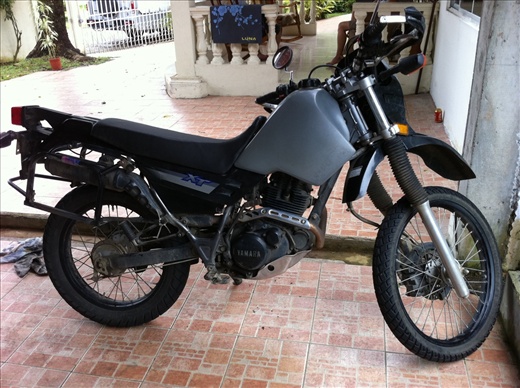
- Sheepskin - Status: MODERATE SUCCESS. I can't imagine having done this trip without my thick, fluffy butt-buddy. Given the size and shape of the XT225's seat, only ol' sheepy made things bearable. With the sheepskin, I could last between 70 and 110 miles before needing a quick respite, and on day trips without it I was dying for a break in under 50 miles. Carrying a full-sized sheepskin, in retrospect, was a little excessive, but it did come in handy as a knee-pad when working on the bike, and as a cushion/mattress when waiting hours for construction workers in Guatemala to let traffic through. However, it's looking a little worse for the wear: it will never be white again, people tend to shrink away from it whenever I hold it up, and it's falling apart after throwing it into a washing machine (although it does smell much better now). Best part of the sheepskin? The funny comments it got. At various times throughout the trip it was identified as sheep, llama, polar bear and dog. Yes, dog.
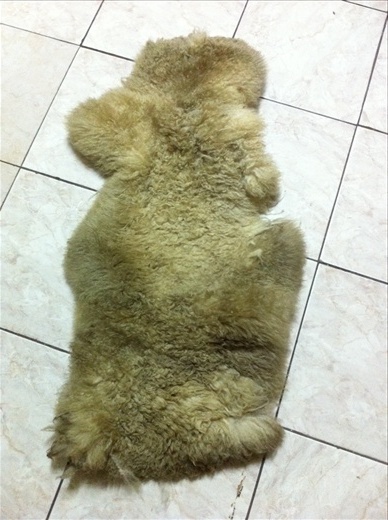
- Happy Trails aluminum pannier system - Status: SUCCESS. They're a little scuffed, a little dinged, and a little bent, but these suckers are just as waterproof, secure and durable as when I bought them. Back in Guadalajara I had to hammer on one a bit to get it flush to the pannier frame again (ended up duct-taping a butter knife to the pannier frame to close the gap), and the bolt that attaches the pannier frame to the right passenger peg fell out three times, and is now held on with zip-ties. I tested the waterproofness by dropping the bike in a river, the security by leaving the boxes on the bike in a dodgy town for two months, and the durability by crashing on them twice. They passed on all counts with flying colors. See next section for opinion on aluminum versus Pelican versus soft luggage.
- Pirelli Scorpion tires - Status: SUCCESS. These babies survived in a big way. After 9,500 miles, the front tire is nowhere near needing replacement, and the rear, while thinner, is usable on pavement for at least another 1,000 miles, especially once I'm not traveling with full panniers. They were excellent on pavement, but in the future I would like something a little knobbier for dirt, mud, rock, etc. Still, they carried me all the way here without a fuss, and, best of all, I didn't get a single flat tire the whole way.
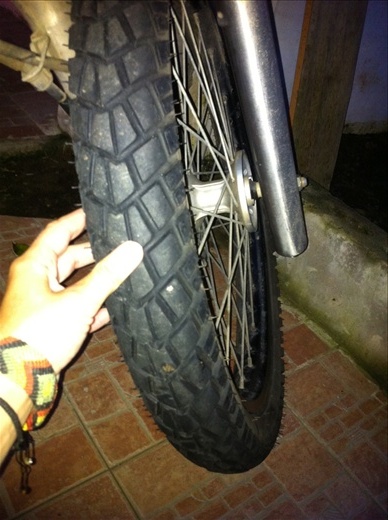

- Fieldsheer mesh jacket - Status: SUCCESS. I'm a big fan of the jacket. It fits well, it breathes well, it sticks out like a gringo in Michoacan, and I'm quite sure I would have broken my shoulder in the Mexico-crash without the armor in the jacket.
- Shift Kevlar-lined jeans - Staus: SUCCESS. I'm a huge fan of these jeans. The Kevlar lining made me feel much more secure while riding, although the only two crashes I had were impact-crashes, while Kevlar only protects from abrasion. In fact, I was punctured straight through them a couple weeks ago, which just goes to show that Kevlar only works in certain situations. Even though proper padded/armored riding pants would probably be a safer bet, I love these for their versatility: not only good on the bike, they looked damn hot as well. After six months of nearly continuous wear, some of the seams are starting to fray, but nothing is coming apart just yet.

- Vega waterproof leather riding boots - Status: MODERATE SUCCESS. These boots were absolutely fine for the trip, but they weren't perfect. I never slipped in them, they were comfy enough for walking around towns and borders without thinking twice, and the snug dual-zipper setup meant they fit well. On the downside, the soles are beginning to separate from the uppers, they stink to high heaven, the liners are not removable for washing, and the waterproofness was not complete. In most rainstorms they were fine, but in heavy downpours and river crossings they let water in. Also, I think I would like higher boots next time, since these were too short to protect my shin in my last crash, resulting in puncture wound to the bone.
- Homemade tool tube - Status: SUCCESS. The tool tube, overall, worked very well. I had to change the original zip-tie setup to metal hose-clamps, and then it stayed on perfectly. It fit all my tools and a puncture kit and a rag, no sweat. Next time I make one, though, I'd like a threaded cap because the non-threaded one got glued on whenever conditions were wet and dirty. Also, the hose-clamps dug into the pannier frames and allowed them to rust a bit. In the end, I started keeping my multi-tool and three-pronged 8-9-10mm socket tool in my jacket pocket because they were used so often, it wasn't worth opening the tool tube every time. Additional perk: the length of the tube was perfect for creating a stand to get my rear wheel off the ground for chain lubing.

- Use of regular rain gear while riding - Status: SUCCESS. Months ago, before I knew anything about riding and gear, I opted to forego fancy (and expensive) riding gear with zip-in waterproof liners, choosing instead to wear regular rain pants over my jeans and a regular rain jacket under my riding jacket. To my surprise and delight, it worked perfectly. I never had a single drop of water on my body after riding through Central America in the rainy season. And, better yet, the waterproofs packed down small and were usable as regular rain gear while not on the bike. For the record, my rain pants are five-year old Helly Hansons, and my rain jacket is a five-year old REI.
- Note on bike modifications: Before leaving on the trip, I installed numerous additions on the bike. The 4-gallon Clarke tank was awesome. The range on it was about 300 miles in theory, but I only ran it to reserve once (in Baja), and otherwise had copious amounts of fuel wherever I went. I didn't have to carry spare fuel a single time. The Moose Racing hand guards probably saved my shifting and brake levers numerous times, and the matching bark busters kept my hands warm and safe from flying rocks on the highway. The kickstart, which was hell to install back in the winter when I didn't have the adequate tools or knowledge, came to the rescue twice in the past few weeks, once when the battery was dead on a beach in the middle of nowhere, and once when my engine was flooded. The cigarette-lighter power adaptor never came in handy because Mexico and Central America are full of electricity.
Non-Motorcycle Specific Gear and Equipment:
- MSR Dromedary water bag - Status: FAILURE. I bought the bag because not only does it hold water perfectly, it can also hold gasoline without any degradation. Of course, I never wanted to put gasoline in my water bag, so I never used it for that purpose. As for holding water, it was fine, but not necessary for the trip. I ended up using simple disposable plastic water bottles, going through about one every month or two. Only actual failure of the product: a few months ago the lid started leaking. Really? A leaky lid on a $40 water bag? Good thing I bought it at REI.
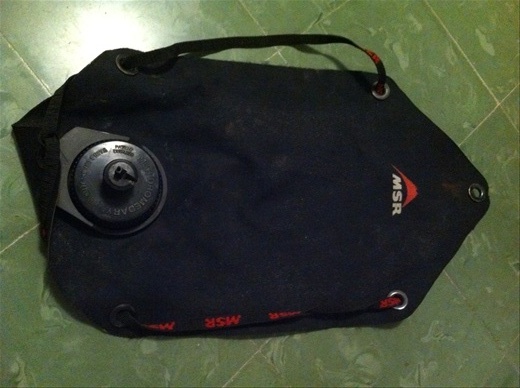
- Vibram Five-Finger hiking shoes - Status: SUCCESS. I love these shoes. Not to say they're perfect, but I sure do like them. They're small and easily packable, they're extremely comfortable, they worked very well on all but one of my volcano hikes (the other one would have sliced through any sole, not just these), and they were perfect for hikes involving lots of water crossings, like Corcovado. On the downside, the sole is already beginning to separate from the upper, and they stink to high heaven, even after washing. Guess that's what you get for wearing shoes with no socks. As for the sole-separation, again, REI will come to the rescue.
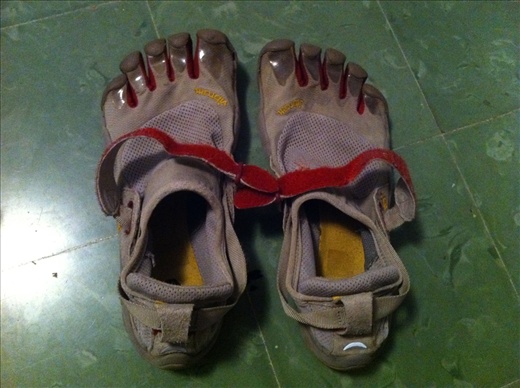
- Hennessey Ultra-light Hammock - Status: SUCCESS. I love, love, love this hammock. In the past six and a half months, I spent 46 nights swinging in the breeze, in all sorts of conditions. It took awhile to get used to it, but once I was settled in, I slept like a baby every night. Even during intense wet-season downpours, I remained as dry and as snug as a bedbug in a hostel bed. It saved me quite a lot of money (fifteen free nights in Baja, most other nights $3 or less to hang a hammock versus $9 or more for a dorm bed) and enabled me to camp with minimal luggage. It's a little chilly in that hammock, but it's perfect for Central America. Next time, I want a sleeping bag liner, and maybe a blanket, instead of a sweaty down sleeping bag.
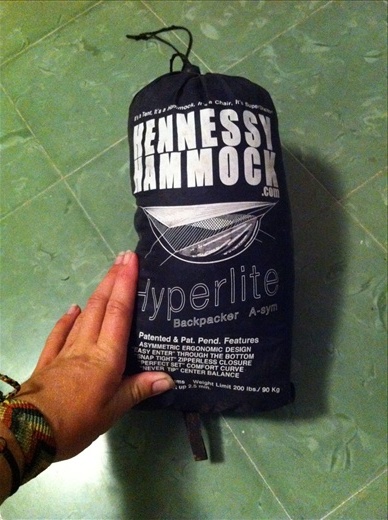
- Primus Omni-Fuel camp stove and bottle - Status: SHIPPED HOME. Perfectly good stove, just wasn't terribly useful in Mexico, so I sent it home. There's so much cheap, good food everywhere, there was no need to lug it around. Then, in Central America I was staying at hostels every night, and they have kitchens. The only multi-day hiking I did was in Corcovado, and the people I was with had stoves to share with me.
- Steri-Pen - Status: SUCCESS. Love the Steri-Pen. I was able to purify my own tap water in two minutes everywhere I went, on one set of batteries over the course of six months. It saved innumerable bottles from going to the landfill, and probably saved me enough money to have paid off the Steri-Pen itself. Great in the backcountry and for travel.
- Patagonia Stuff-Sack Backpack - Status: DYING. This pack is awesome for its size and weight. Packed down, I was able to stuff it into my 1-liter cook pot. Unfolded, I could fit hammock, sleeping bag, clothes, water, first aid kit and some food in it. Not quite enough for overnight trips, but darn close. However, it doesn't carry weight very well. After lugging stuff to Little Corn Island in it, the seams began to fall apart. Fortunately, a little easy sewing fixed that, and everything is holding so far. Still, I'm disappointed that Patagonia couldn't create sturdier seams. The newer edition of the pack may be sturdier.
Future gear changes:
Next time I do a trip like this, I would change a few things. I would like a slightly larger bike, now that I know how to handle motorcycles in general. I would trade the chain-and-padlock security system for a disk-lock and a cable lock. I would also bring a bike cover, both to protect it from the elements (for instance, when I ditch it in the jungle for two months) and because eyes seem to slide over a bike under a cover. The HT panniers were great for pavement riding, but rougher roads made them clang around a lot, and things tended to rattle loose over time; in the future, I'd like soft luggage for rough roads, and the HT boxes for pavement and long trips. Don't know how to arrange that on a trip like this, though. The HT system was essential for my piece of mind since they were so secure and so waterproof.
I wouldn't change my clothing selection one bit (although I'm craving more variety in my undergarments right now, and I can't wait to have a bra that's not held together with safety pins), with the exception of underwear. Now I understand why the women on HUBB and ADV advocate thongs: there's nothing so uncomfortable as sitting directly on seams for hours on end. Other than that, I was warm and dry when I needed to be, and cool and cute when I wanted to be.
I only had my iPhone with me for communications, with the service shut off, so it was essentially a miniature computer. It was the most technology I've ever carried, and it was perfect for my needs. I also used it as my only camera, and it did very well. I also had a Kindle, which was an excellent addition to my luggage...until I got it wet in Corcovado.
I think that's about it. Whew! Gear overview complete.